 MANUFACTURERS, IMPORTERS, AND RETAILERS. P-T |
||
|
References: To produce this extensive list the following sources were consulted: Encyclopaedia of the Magic Lantern. The Magic Lantern Society, London, England, 2001. Van Toverlantaarn tot Kinematograaf. Vera Tietjens-Schuurman. Stichting Peter Bonnet Museum, Rottevalle, Friesland, the Netherlands, 1979. Laterna Magica, Zauberwelt und Faszination des optischen Spielzeugs. Ernst Hrabalek. Keysers Sammlerbibliothek G.m.b.H., Regensburg, Germany, 1985. and others. |
||
PALMER, EDWARD English manufacturer and retailer of scientific instruments in London who offered magic lanterns for sale. In 1845 the business was taken over by Horne, Thornthwaite & Wood. (1828-1845) |
||
PARKES & SON, JAMES English instrument makers, active in Birmingham. The company offered among other tings side by side pairs for dissolving views, a wide collection of slides, oil lamps and 'Fine' and 'Extra Fine' oil. (1860s) |
||
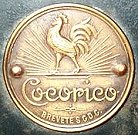 |
PATHÉ, CHARLES Charles Pathé (1863–1957), French industrialist and film pioneer who was the first to develop a system for mass production of films and controlled a vast network of production and distribution facilities during the first years of the 20th century. Charles started his carrier as an importer and dealer of phonographs and phonograph cylinders, and later expanded his business with projectors and films. With his brother Émile, he founded Pathé Frères (Pathé Brothers) in 1896 in Paris. The company also began to produce movies and published the screen magazine 'Pathé Pictorial'. In 1908 Pathé had a lot of foreign branches and until 1914 they dominated the world film market. At the break out of World War I Pathé took off for the U.S.A. to strengthen the American branch, Pathé Exchange. When he resumed the production in France in 1917, Pathé lost the competition with foreign, mostly American, producers. In 1917 he began to sell the company's equipment, production studios, and exhibition circuits. He retired in 1929, but the company remained in existence as a leading film distributor. Some well-known products: The Cocorico projector, using Pathéorama films, a domestic filmstrip system, patented in 1923. The non-flamable 35 mm filmstrip with one set of perforations removed, was mounted in a papier-mâché or bakelite hand-held viewer that could be placed for projection into the projector. Pathé's Luxa lantern of the late 1930s was also provided with fittings to project the Pathéorama film strips. The company also produced the well-known 'Pathé Baby' and other projectors for the projection of 9,5 mm films on reels or in cassettes. |
|
PATHÉ FRÈRES See: Charles Pathé. |
||
PECK & SNYDER American supplier of toys, novelties and sports goods settled in New York. The firm offered a range of slides, mechanical slides and magic lanterns, like the No. 2 Electro Radiant Magic Lantern, made by the World Manufacturing Co. (1880s-1900s) |
||
PELLIN, FRANÇOIS-PHILIBERT French optical instrument and magic lantern maker. In 1885 Pellin formed a partnership with the optician and precision instrument maker Jules Duboscq. After Duboscq's death in 1886 he took over the running of his shops and workshops in Paris. They were selling the large projection phenakistiscope designed by Duboscq around 1853 and the classic Duboscq Lanterne Photogénique. In 1913 Pellin founded a new company in partnership with his brother. |
||
PERFECTION LANTERN SLIDES American manufacturer of the Meinhardt glass clock-projection slide with settable hands. (1912) |
||
PERKEN, SON & Co. LTD Zie: Perken, Son & Rayment. |
||
  |
PERKEN, SON & RAYMENT The British firm of Lejeune & Perken was established in 1852 in London, manufacturing optical, photographic and other scientific instruments. Their trade name 'Optimus' was first registered on 9 December 1885 and was applied to magic lanterns as well as an extensive range of photographic equipment. Soon after that the business continued under the name Perken, Son & Rayment. Finally the firm became Perken, Son and Co. Ltd in 1900 and continued to be listed into the 1920s. (See also: Magic Lanterns, Perken, Son & Rayment) |
|
PERRY MASON Co. American publisher of The Youth's Companion magazine. |
||
 |
PETTIBONE MANUFACTURING COMPANY American manufacturer of 'Military and Society Goods' who sold magic lanterns in Ohio. In 1872 James Pettibone took over the military goods store from John Boner under his own name. The company sold the spectacular 'New Improved Sciopitocon with Revolving Disc', in which a series of circular slides were set in a large spoked wheel. (See also: Magic Lanterns made by Pettibone Manufacturing Company) |
|
PIKE & SONS, BENJAMIN Father and son Pike were American optical and scientific instrument makers in New York. Benjamin senior started at a workshop in New York in 1804 and Benjamin junior joined him in 1831. When two other sons became partner the business was incorporated as Benjamin Pike & Sons. Benjamin senior died in 1863. The business was carried on by two of his sons Daniel and Gardiner, for Benjamin junior had set up his own business in 1843, and the name became Benjamin Pike Sons & Company. The two companies produced scientific and technical equipment, including magic lanterns and slides. (1804-1860s) |
||
PIZZI & NEGRETTI English scientific instrument makers. The business was succeeded by Henry Negretty & Co. |
||
PLACE, J. English optical retailer in Birmingham, known to have sold magic lanterns. (c. 1830s-c. 1860s) |
||
 |
PLANK, ERNST The German Ernst Plank Company was seated in the Hochfederstrasse 40 in the toy town of Nuremberg. In 1866 it was enrolled in the Commercial Register of Nuremberg as 'Ernst Plank, Fabrik Optischer und Mechanischer Waren'. Besides magic lanterns the firm also made all kinds of tin toy steamboats and train sets. Ernst Plank was the second largest in Nuremberg, after the 'Gebrüder Bing'. At the turn of the century they were turning out annually 150,000 toy and domestic magic lanterns in various sizes including combination slide lantern-cinematographs. Almost all the lanterns from Plank are supplied with its trade mark, bearing the initials 'E.P.' beneath a winged wheel. Also the label on the boxes always show his well known trade mark. By this Plank's lanterns are always easy to recognize. The lanterns bore such impressive model names as 'Solid', 'Globus', 'Triumph', 'Gloria', 'Helios' and 'Prophet'. The company survived the First World War, but magic lantern production gradually ceased in the 1920s. In 1930 the factory was sold to Hans and Fritz Schaller, who specialized in home movie equipments. After World War II their company was known as Noris Projektion GmbH. (See also: Magic Lanterns Ernst Plank and Colourful Labels E.P.) (1866-1930) |
|
PLATT, E.G. (PLATT & WITTE) English optical lantern manufacturer and photographic brass finisher who advertised magic lanterns. (c. 1890s) |
||
PLÖSSL, SIMON Austrian mechanic, optician and lantern maker. In 1823 Plössl founded his own optical workshop in Vienna, manufacturing microscopes and telescopes. Later he traded as S. Plössl & Comp. and offered magic lanterns, sciopticons, projecting microscopes and other optical instruments. Later owned by M. Wagner the firm was one of the first to use electric light for projection. Plössl made giant sciopticon lanterns, weighing several hundred pounds and was still active at the end of the 1890s. |
||
POCHER, CARL ANTON German toy manufacturer in Nuremberg who improved a process for producing chromolithographic transfers. In 1860 he manufactured his so called metachromotypes, cold-water transfer pictures which were later used for the mass production of lantern slides. |
||
POLLOCK & STEWART English opticians who sold magic lanterns. A label reads: 'Pollock & Stewart, Opticians, 41 Renfield Street, Glasgow'. |
||
PRESTON, NANNIE English gifted painter and illustrator. She is one of the few illustrators whose work was used for lantern slides that are known by name. Both her father and grandfather, both called John Preston, were accomplished artists in watercolour and oils. Nannie Preston worked for Riley Brothers on their production of mainly religious narrative sets. She created famous sets like 'The Prodigal Son', 'Pigrim's Progress', 'The Scarlet Letter' and most of the slides in the 'Ben-Hur' set. Her set of illustrations for Pilgrim's Progress, intended for an American publisher, went down with the Titanic. Her signature appears at the bottom of at least some of her designs. After her marriage her art was signed Nannie Preston Rosevaer or NPR. (1890s) |
||
PRIMUS Trade name adopted by W. Butcher & Sons for their lantern slides, lanterns and a wide range of accessories. The name is particularly associated with the Junior Lecturers' Lantern Slides introduced by Butcher at the beginning of the 20th century and marketed up until the Second World War. The slides are boxed in sets of eight, each set forming a complete tale. You'll find the complete catalogue at Primus Junior Lecturers' Slides. |
||
PRITCHARD, ANDREW English optician and spectacle maker, working in London. Prichard sold magic lanterns. In 1854 the business was taken over by Samuel Straker. (1827-1854) |
||
PRITCHARD, GEORGE English optician and instrument maker active in London; known to have sold magic lantern. (1832-1855) |
||
PRYOR & CLAIRE American slide dealing company in New York that sold slides on topical themes. The company was especially active after the sinking of the Titanic. They chartered a tug to take photographs of survivors on board of the rescue ship Carpathia and released a set of 30 lantern slides about the disaster. (c. 1912) |
||
PUMPHREY, ALFRED English manufacturer of magic lanterns, slides and accessories. Originally the firm advertised as Pumphrey Brothers, Birmingham. In 1901 R.H. Clark took over the lantern side of the business. (1870s-1901) |
||
 |
QUEEN, JAMES W. American manufacturers of optical goods, lanterns and slides. James Queen was an employee of McAllister & Son who started his own company in Philadelphia in 1853. In partnership with Samuel L. Fox his firm sold 'Magic Lanterns, Marcy's Sciopticon, Stereopticons, Oxyhydrogen microscopes and Polariscopes. (1853-1870s) |
|
RABIQUEAU French magic lantern and optical equipment dealer, operating in Paris. (1770s) |
||
RADIGUET, ARTHUR French lantern manufacturer. Founder of the company Radiguet & Massiot. |
||
RADIGUET & MASSIOT The company was founded by Arthur Radiguet and his father Honoré in Paris in 1880. Arthur was already a specialist in electricity and optics long before that time. In 1900 Arthur Radiguet formed a partnership with his son-in-law Gaston Massiot and took over the business of Alfred Molteni. Radiguet & Massiot produced slides and professional projection lanterns of high quality. His fascination by the X-ray phenomenon became Arthur fatal in 1904 when he died as a result of excessive exposure to radiation from the Crookes tubes used in his X-ray work. After his prematurely dead Massiot continued to run the company alone. |
||
RAU, WILLIAM H. American slide manufacturer and retailer in Philadelphia. The business offered thousands of slides, 'arranged in Lecture Sets with Readings, Rented for Private and Public Entertainments' (advertisement 1904). (1890s-1900s) |
||
REEVES, RICHARD Father and son Reeves were optical instrument makers in London. Senior was one of the greatest optical technicians of the 17th century who collaborated closely with the leading scientists of his day, among them the inventor of the magic lantern, Christian Huygens. In his London shop he was assisted by his sons Richard junior and John. There he demonstrated 'the effect of a dark lantern'. In 1664 Richard senior was briefly imprisoned for killing his wife, and after this the business was probably conducted by his sons. Senior died in 1666, junior around 1679, and the business appears to have been continued into the 1680s by the other son John. (1640s-1680s) |
||
REUTER German optician in Hanover, advertising magic lanterns that could be carried in a pocket. (c. 1753) |
||
REYNOLDS & BRANSON Ltd. English suppliers of scientific apparatus. Started as a pharmacy in the early 19th century the business was supplying a large range of scientific apparatus by the 1890s. They produced the 'Phoenix', a high-quality magic lantern of polished walnut, an Universal Scientific lantern, a projecting microscope and a 'New Focus Keeping Arc Lamp for Optical Lanterns' (ad 1896). The firm was still in business in the 1970s, supplying scientific instruments. |
||
RICHARDSON, MATTHEW English optician, member of the Spectacle Makers Company from 1737, who advertised magic lanterns. (c.1740s-1752) |
||
RICHTER, LUDWIG German manufacturer of dissolving view lanterns and slides in Berlin. After his death the firm was taken over by Miessl. Unfortunately after that the quality of their products declined. (c. 1875-c. 1900) |
||
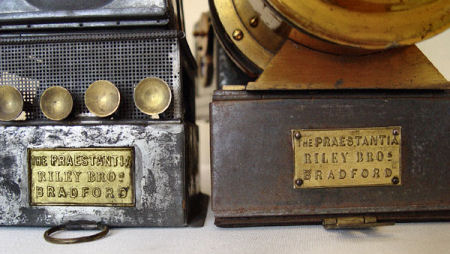 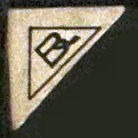 |
RILEY BROTHERS English slide and lantern manufacturers and dealers, active in Bradford. In 1887 the business was founded as a branch of Joseph Riley's successful textile business, to provide an occupation for his sons Herbert and William. William became the driving force of the Riley lantern business. At its height, around 1895, the company also owned a branch in New York, with agents in seven cities across the USA. Though the lanterns they supplied are often labelled as their own, their business was mainly supply rather than manufacture. Some slide sets however were created in their own premises. They also ran a successful slide hire department, carrying a vast stock of slides from all the major slide manufacturers. William was a confirmed Methodist and his slide business remained close to those teachings, with religious and instructional subjects predominating, while the hire to Sunday schools and churches seems to have been the companies mainstay. William Riley collaborated with Bamforth & Co., in making films around the end of the 1890s. After World War I the company declined. A younger brother, Arnold, restarted the business in 1914, but without success. (c.1887-1914) |
|
ROEBUCK, ALVAH CURTIS Alvah Curtis Roebuck, co-founder of Sears, Roebuck and Co., was born on January 9, 1864, in Lafayette, Ind. In 1895, Roebuck asked Sears to buy him out. However at Richard Sears' request, he took charge of a division that handled watches, jewellery, optical goods, and later, phonographs, magic lanterns and motion picture machines. He later organized and financed two companies: a manufacturer and a distributor of motion picture machines and accessories. |
||
ROOSE, I.F. German optician in Nuremberg who manufactured lantern slides and magic lanterns. Inside a box a note was found with the text 'Die Weilen viel slechte Laterne Magica nach gemacht werden, also habe vor nötig befunden die meinigen mit diesen Zeichen zu unterscheiden, und an zuzeigen dasz davon alle Sorten mit fein gemahlten Vorstellungen, wie auch viele andere optische Machinen zu haben sind.' (Because many of my lanterns are imitated I need to distinguish mine by this mark...) accompanied by an escutcheon with a rose, flanked by two lions, and the coat of arms of Nuremberg. (c. 1830) |
||
ROSS, RICHARD Lichtbilder Anstalt Richard Ross Dresden. German dealer of lantern slides. From 1918 the label shows the initials "L.A.R.R.D.". |
||
 |
ROSS & Co., A. Andrew Ross was an English optician and scientific instrument maker in London who sold and possibly made magic lanterns from 1830. His daughter married J.H. Dallmeyer, who founded a lens factory in 1860. After Andrew's death in 1859 the business was continued by his son Thomas under the name A. Ross & Co. The firm advertised an extensive range of magic lanterns as well as photographic equipment and was a major manufacturer of lenses and optical instruments. Manufacturing lenses continued under various names until the early 1970s. They closed finally in July 1977. The factory buildings remain though internally reconstructed as an adult technical training centre. They continued to make binoculars and specialised optical components for the armed forces including gun sights for tanks etc., and continued to support their cinema projector with occasional batches of spares up until the last. (1830-1970s) |
|
 |
SANDHAM & Co. English photographic retailers and manufacturers, active in Blackburn. George Cooper Sandham, previously a brass finisher, founded the firm in 1897 and his brother John joined him later. George travelled widely as a lanternist and worked with many famous lecturers. The company ceased manufacturing equipment around 1910. John died in 1929 and the company finally closed when Georges retired in 1933. (1897-1933) |
|
SCARLET, EDWARD English optician working in Soho, London, known to have sold magic lanterns. The business was taken over by his son Edward from 1743. (1705-1743) |
||
SCHOENFELD & COMPANY Manufacturers of oil colours, established in Düsseldorf. Their transparent oil paints were frequently recommended for painting slides around the 1890s. |
||
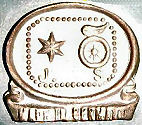 |
SCHOENNER, JEAN German toy manufacturer in Nuremberg, founded in 1875. By 1892 the factory made 300,000 steam engines and probably a similar number of magic lanterns. The firms trade mark was SN, in later years it became JS. Around 1905 an important part of the firm's tooling machinery had been taken over by Johan Falk. After 1913 all traces of the firm disappear. (1875-c. 1913) |
|
SCOTT & VAN ALTENA American makers of Singalong slides having its seats at New York. The slide makers John Duer Scott and Edward Van Altena formed a company together in 1904. Van Altena was the photographer, Scott the colourist. They produced a lot of Singalong slides, with hand coloured, photographic montage effects, usually sold in sets of 16, including title and chorus. (Singalong slides are live model illustrated song slides, witch were shown in nickelodeons where local talent lead the audience singing.) After the dissolution of the firm around 1919, each partner continued separately. |
||
SCOTT, JOHN English supplier of magic lantern slide outfits for home amusement. Scott sold lanterns and slides from his shop premises in London from c. 1797. In 1806 he opened the Sans Pareil Theatre, thus creating a venue where he could explore a more highbrow version of the phantasmagoria, beside the considerable vocal talents of his daughter. |
||
SCOTT, JOHN DUER American photographer, slide maker and colourist who patented a lightweight cardboard frame of the 3¼ x 4 inch size, for a single small glass without cover glass. Together with Edward Van Altena he formed the company Scott & Van Altena in 1904. |
||
 |
SEARS, ROEBUCK & Co. American mail-order retailers of magic lanterns and lantern equipment in Chicago, that claimed to be the "Cheapest Supply House On Earth". See also: Enterprise Optical Manufacturing Co. |
|
SECRETAN, MARC In 1855 Secretan took over the business that was founded by Noël Jean Lerebours. |
||
SELVA, DOMENICO Italian optician and optical instrument maker. His flourishing optical instrument shop in Venice, patronised by noble customers, sold among a wide range of other optical instruments, camera obscuras and magic lanterns. (c. 1740) |
||
SHARLOW BROS Co. American lantern manufacturers and distributors, active in New York. Their lanterns were sometimes used as a light source for Edison's Projecting Kinetoscope. |
||
SHINSHINDO Japanese manufacturers of magic lanterns operating in Tokyo around 1900. |
||
SIMPSON, CHARLES English painter of miniatures who also painted lantern slides. It was William Westley of Carpenter & Westley who stimulated his slide-painting endeavours. (1833-1847) |
||
SMITH Scottish lantern slides manufacturers. Some of their slides are marked 'Manufacturers to His Majesty [William IV]'. (c. 1830) |
||
SMITH, CHARLES British artist who painted a lot of Royal Polytechnic Institution lantern slides, including 'The Holy Land' (after David Roberts), scenes in Mexico and Italy, and 'Robinson Crusoe'. |
||
SMITH, JOSEPH English optician in London, known to have sold magic lanterns. (1811-1857) |
||
SOLEIL, JEAN-BAPTISTE FRANÇOIS French optician and optical instrument maker. In 1823 Jean-Baptiste followed his father's tracks when he started a shop in Paris in. There he improved projection illuminants and lanterns for demonstrating optical experiments. In 1834 he took Jules Duboscq as an apprentice, the man who should later become his son-in-law. After his retirement Soleil passed on his business to his son Henri and Jules Duboscq. |
||
SOLOMONS, SAMUEL & BENJAMIN English sellers of magic lanterns, London. (1839-1874) |
||
SOPER & STEDMAN English slide manufacturers and colourists in London (also referred to as Stedman & Soper). |
||
SOULIER, CHARLES See: Ferrier et Soulier. |
||
SPENCER, BROWNING & RUST See: Browning. |
||
SPENCER, BROWNING & Co. See: Browning. |
||
SPENCER LENS COMPANY American lens and optical instrument maker, founded in New York. The company made simple home lanterns as well as top-of-the-line projectors. Several models were named Delineascope. (c. 1885-1920) |
||
STANLEY, W.F. British optician and mathematical instrument manufacturer to H.M. Government, Science and Art Department, Council of India, etc., Guy's, Bartholomew's, St. Thomas's and other hospitals. The comprehensive catalogue of Magic Lanterns, Dissolving View Apparatus and Slides has 80 pages. Cover shows Stanley's address as 13 Railway Approach, London Bridge, S.E. They were at this address from 1890 onwards until the early 1900's. |
||
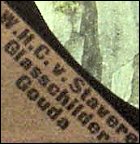 |
STAVEREN, W.H.C. van Jacob Willem Hendrik Christiaan was a Dutch glass painter, who lived in Gouda, at first at the address Raam 14a and later at the Prins Hendrikstraat 316. He was born on Aug. 10th 1876 as the son of the decoration painter Hermanus Catharinus van Staveren. In his advertisements he called his own buisness the 'Largest Workshop on Magic Lantern Slides'. Van Staveren painted among others the Parable of the Good Shepherd and a Dutch version of Curfew shall not ring tonight (De Avondklok). His slides are usually labelled in the bottom left-hand corner with a triangular label. |
|
STEDMAN, FREDERICK J. See: Soper & Stedman. |
||
STEEG & REUTER, Dr. German scientific lantern manufacturer in Homburg, near Frankfurt am Main. (c. 1860s) |
||
 |
STEWARD, JAMES HENRI English manufacturer and retailer of magic lanterns and scientific instruments in London. Steward was the head optician of the company and had businesses at 406 and 66 Strand and 54 Cornhill in London. In the mid 1800s he became the optician to Her Majesty's Government and the National Rifle, and National Artillery Associations. The firm produced simple single lanterns as well as biunials and triunials, all of a very high quality. In 1996 one of the firm's triunial lanterns was sold for £33,000 at Christie's in London, a world record auction price for a lantern set. By the time of Steward's death in 1896 the business was directed by his sons. |
|
STILTZ & Bro., LOUIS American supplier and possible manufacturer of magic lanterns. The plate on the access door of one of their lanterns reads: 'LOUIS E. STILTZ & BRO MILITARY & SOCIETY GOODS PHILADELPHIA'. |
||
STÖHRER, EMIL German lantern maker with workshops in Leipzig and Dresden. Stöhrer senior was in partnership with his son Franz Emil junior in 1864. |
||
STÖHRER, FRANZ EMIL Son of Emil Stöhrer. German lantern maker. After his education in the mechanical arts in Paris, Franz Emil entered into partnership with his father from 1864 and took the sole direction of the firm in 1880. He is considered as the inventor of the 'optical bench', based upon a separate placing of the lens and the condenser in a Sciopticon. |
||
STOLTING & Co., C.H. American laboratory supply and optical instrument maker, active in Chicago, Illinois. Among the complete range of laboratory equipment was an universal projection apparatus for vertical, horizontal, opaque, slide and microscopic projection. (c. 1880-c. 1930) |
||
STRAKER, SAMUEL See: Andrew Pritchard. |
||
TALBOT, MAURICE Son of Romain Talbot. |
||
TALBOT, ROBERT Photographic dealer and equipment manufacturer. From 1889 Robert was a partner in the firm of his father Romain, who ran one of the best-known photographic and magic lantern firms in Germany. Robert represented Clement & Gilmer's Vitagraphe from 1896 and introduced the Erte camera in 1912. After the death of his brother Maurice in 1927, Robert became sole owner of the firm, which was by this time established in Berlin-Spandau. |
||
TALBOT, ROMAIN Photographic dealer in Berlin. Romain Talbot founded his business in Paris in 1855 and moved to Berlin at the outbreak of the Franco-Prussian war. In 1873 he introduced the Sciopticon lantern into Germany. In 1889 the firm was taken over by his sons Robert and Maurice. |
||
TAUNT, HENRI W. English photographer and magic lantern lecturer. Taunt was an apprentice of the Oxford daguerreotypist Edward Bracher and started his own business in 1868. There he sold his 'Shilling Views' of Oxford, the river Thames and the surrounding countryside. His photographs of landscapes, portraits and the scenery of southern England were real works of art then and are valuable social documents today. Beside this Taunt gave many lantern lectures. An advertisement claimed 'Over 1200 lectures and entertainments have been successfully given'. After 1900 Taunt produced picture postcards too. |
||
THEMME German maker of moving slides. (c. 1710) |
||
THEOBALD & Co. English manufacturer/wholesaler of an impressive amount of magic lantern slide sets. Theobald (1858-1926) founded his business in the 1880s in London, England. In spite of the addition '& Co.' the business was the sole property of John Theobald. The company also supplied lithographic transfers in sheets, for slide production by the purchaser and slides on special transparent paper, for placing between two glass plates. (See also: Do-it-yourself magic lantern slides.) He run the business until October 1911. |
||
THOMIN, MARC-MITOUFLET French optical instrument maker and dealer who sold all types of optical equipment and effects, including magic lanterns. (c. 1740s) |
||
THOMPSON & Co., A.T. American importers and dealers of magic lanterns in Boston, Massachusetts, who sold the Boston Ideal Triple Dissolving Stereopticon and the Reflectoscope for both opaque and slide projection. (c. 1910) |
||
THORNTHWAITE See: Horne, Thornthwaite & Wood. |
||
TOMS, H. LUSCOMBE English manufacturer and retailer of magic lanterns established in 1870 in London and continuing into the 1900s. |
||
TOWNSON & MERCER Ltd English suppliers of scientific instruments who sold chromatropes and mechanical slides demonstrating colour, electrical, mechanical and hydrobased principles. The company still exist, now supplying temperature controlled production and test equipment. |
||
TREFFLER, CHRISTOPH German mechanic and lantern maker in Augsburg who manufactured automata, Zauberlanternen (magic lanterns), clockwork lanterns and 'optical curiosities' in the late 1670s. |
||
TROTTER, JOHN This Scottish firm dealt in lantern and cinematographic equipment and sold Trotter's Educational lantern in 1894. (c. 1890s-c.1912) |
||
TSURUBUCHI, HATSUZO Japanese distributor of photographic equipment, photographer and lantern and slide manufacturer. Tsurubuchi was hired by the Ministry of Education to copy the American lantern and slides brought to Japan by Seiichi Tejima. Around 1875 Tejima returned to Japan after her studies in the USA with a magic lantern and some scientific slides and proposed the government to provide lanterns and slides to teachers' colleges throughout the country. The plan was terminated in 1883 because of the high costs involved. After that time Tsurubuchi independently continued to supply lanterns, slides and later also 35 mm film equipment to educational institutions throughout Japan. |
||
TYLAR, WILLIAM English manufacturer of photographic equipment, including magic lanterns, operating in Birmingham. Many of the lanterns were produced under the Criterion trade name. |
||
TYLER, WALTER CLEMENT English lantern and slide manufacturer and retailer. After a career as a lantern exhibitor, in 1885 Clement opened a shop in London were he retailed and apparently also manufactured lanterns and lantern equipment. His business became one of the largest retailers of lanterns, accessories and slides in England. One of Tyler's best-known lanterns was the Helioscopic, which went to many models. His 'skeletton' lantern was a compact lantern with a simple cast-iron frame in stead of the conventional body, and a limelight jet being enclosed in a light-tight metal tube. At the end of the 19th century the firm bought the lantern slide stock of John Theobald & Co. |
||
 |
| |
©1997-2025 'de Luikerwaal' All rights reserved. Last update: 07-02-2025. |